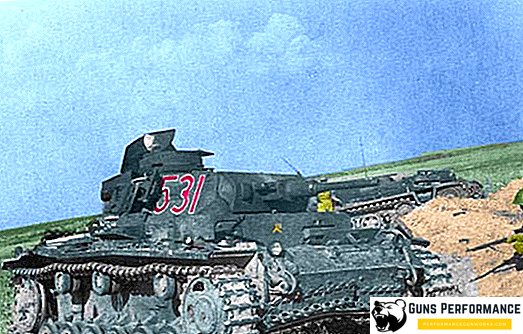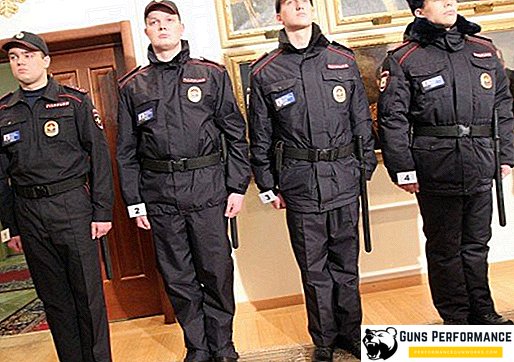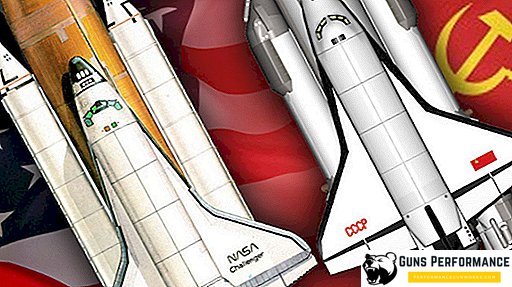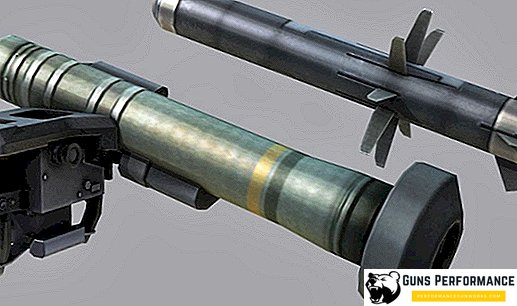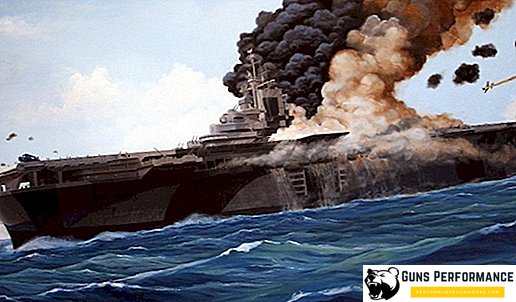The appearance of tanks on the battlefield was one of the most important events of the military history of the last century. Immediately after this point, the development of tools to combat these menacing machines began. If we carefully look at the history of armored vehicles, then, in fact, we will see the history of the confrontation of the projectile and armor, which has been going on for almost a century.
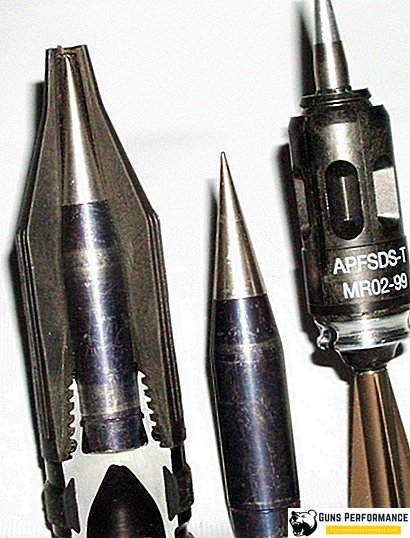
In this irreconcilable struggle, one or the other side periodically triumphed, which led either to the complete invulnerability of tanks, or to their enormous losses. In the latter case, voices were heard each time about the death of the tank and the "end of the tank era." However, even today, tanks remain the main striking force of the ground forces of all the armies of the world.
Today, one of the main types of armor-piercing ammunition, which are used to combat armored vehicles, are sub-caliber ammunition.
A bit of history
The first anti-tank shells consisted of ordinary metal blanks, which, due to their kinetic energy, pierced tank armor. Fortunately, the latter was not very thick, and even anti-guns could handle it. However, before the beginning of the Second World War, the next generation of tanks (KV, T-34, Matilda) began to appear, with a powerful engine and serious armor.

The main world powers entered World War II with anti-tank artillery of 37 and 47 mm caliber, and ended up with guns that reached 88 and even 122 mm.
Increasing the caliber of the gun and the initial velocity of the projectile, the designers had to increase the mass of the gun, making it harder, more expensive and much less maneuverable. It was necessary to look for other ways.
And they were soon found: cumulative and substage ammunition appeared. The effect of cumulative ammunition is based on the use of a directional explosion, which burns tank armor, the sabot projectile also does not have a high-explosive effect, it hits a well-protected target due to high kinetic energy.

The design of the sabot projectile was patented as far back as 1913 by the German manufacturer Krupp, but their mass use began much later. This ammunition does not have a high-explosive action, it is much more like a regular bullet.
For the first time, the Germans became active in the use of sub-caliber shells during the French campaign. Even more widely used such ammunition they had after the outbreak of hostilities on the Eastern Front. Only by using sub-caliber shells could the Hitlerites effectively counter powerful Soviet tanks.
However, the Germans were experiencing a serious shortage of tungsten, which prevented them from organizing the mass production of such shells. Therefore, the number of such shots in the ammunition was small, and the soldier was given a strict order: use them only against enemy tanks.
In the USSR, mass production of sub-caliber ammunition began in 1943, they were created on the basis of captured German samples.
After the war, work in this direction continued in most of the leading weapon states of the world. Today, sub-caliber ammunition is considered one of the main means of destruction of armored targets.
Currently, there are even sub-caliber bullets that significantly increase the firing range of smooth-bore weapons.

Operating principle
What is the basis of high armor-piercing effect, which has a sabot projectile? How is it different from the usual?
A sub-caliber projectile is a type of ammunition with a caliber of a combat strike part many times smaller than the caliber of the barrel from which it was fired.
It was found that a small-caliber projectile, flying at high speed, has a greater armor penetration than the large-caliber. But to get high speed after the shot, you need a more powerful cartridge, and, therefore, an instrument of a more serious caliber.

It was possible to resolve this contradiction by creating a projectile, in which the striking part (core) has a small diameter in comparison with the main part of the projectile. The sub-caliber projectile does not have a high-explosive or fragmentation action, it works on the same principle as a conventional bullet, which hits targets due to high kinetic energy.
The sub-caliber projectile consists of a solid core made of extremely strong and heavy material, a body (pallet) and a ballistic fairing.
The diameter of the pallet is equal to the caliber of the weapon; it acts as a piston when fired, accelerating the warhead. On the pallets of sub-caliber shells for rifled guns are established leading belts. Typically, the pallet has the shape of a coil and is made of light alloys.

There are armor-piercing substage caliber shells with a non-separating pallet, from the moment of the shot and until the target is hit, the coil and the core act as a single whole. This design creates a serious aerodynamic drag, significantly reducing the speed of flight.
More advanced are the shells, which after the shot reel is separated due to air resistance. In modern sub-caliber shells, stabilizers provide stability to the core in flight. Often a tracer charge is installed in the tail section.
Ballistic tip is made of soft metal or plastic.
The most important element of the sabot projectile is undoubtedly the core. Its diameter is about three times smaller than the caliber of the projectile, for the manufacture of the core alloys of metals with high density are used: the most common materials are tungsten carbide and depleted uranium.

Due to the relatively small mass, the core of the sabot projectile immediately after the shot accelerates to a significant speed (1600 m / s). When striking an armor plate, the core pierces a relatively small hole in it. The kinetic energy of the projectile partially goes to the destruction of armor, and partly turns into heat. After penetrating the armor, the hot shards of the core and armor enter the space and spread like a fan, hitting the crew and the internal mechanisms of the vehicle. In this case, there are numerous hot spots.
As the armor progresses, the core is ground and shorter. Therefore, a very important characteristic that affects armor penetration is the length of the core. Also on the effectiveness of the sabot projectile affects the material from which the core is made and the speed of its flight.
The latest generation of Russian sabot shells ("Lead-2") is significantly inferior in armor penetration to American counterparts. This is due to the greater length of the striking core, which is part of the American ammunition. An obstacle to increasing the length of the projectile (and, therefore, armor penetration) is the device of automatic loading of Russian tanks.

The armor penetration of the core increases with a decrease in its diameter and with an increase in its mass. This contradiction can be resolved by using very dense materials. Initially tungsten was used for striking elements of similar ammunition, but it is very rare, expensive, and also difficult to process.
Depleted uranium has almost the same density as tungsten, and is also a practically free resource for any country that has a nuclear industry.
Currently, sub-caliber ammunition with a core of uranium are in service with major powers. In the USA, all such ammunition is equipped only with uranium cores.
Depleted uranium has several advantages:
- during the passage of armor, the uranium rod is self-sharpening, which provides better armor penetration, tungsten also has this feature, but it is less pronounced;
- after penetration of armor, under the action of high temperatures, the remnants of the uranium rod flare up, filling the space in the reserve space with poisonous gases.
To date, modern sub-caliber shells have almost reached their maximum efficiency. It can only be increased by increasing the caliber of tank guns, but this will have to significantly change the design of the tank. In the meantime, in the leading tank-building states they are only engaged in the modification of vehicles manufactured during the Cold War, and are unlikely to take such radical steps.

In the United States, active-missiles with a kinetic warhead are under development. This is a common projectile, which immediately after the shot turns on its own booster block, which significantly increases its speed and armor penetration.
Also, the Americans are developing a kinetic guided missile, the uranium rod is a striking factor. After the shot from the launch container, the upper stage is activated, which gives the ammunition a speed of 6.5 Mach. Most likely, by 2020, sub-caliber ammunition will appear, having a speed of 2000 m / s and above. This will bring their effectiveness to a completely new level.

Sub-caliber bullets

In addition to piercing shells, there are also bullets that have the same design. These bullets are very widely used for 12 caliber cartridges.
The 12 caliber sub-caliber bullets have a smaller mass, after a shot they receive greater kinetic energy and, accordingly, have a greater range.
Very popular sub-caliber 12-caliber bullets are: the Poleva bullet and the Kirovchanka. There are other similar ammunition 12 caliber.


